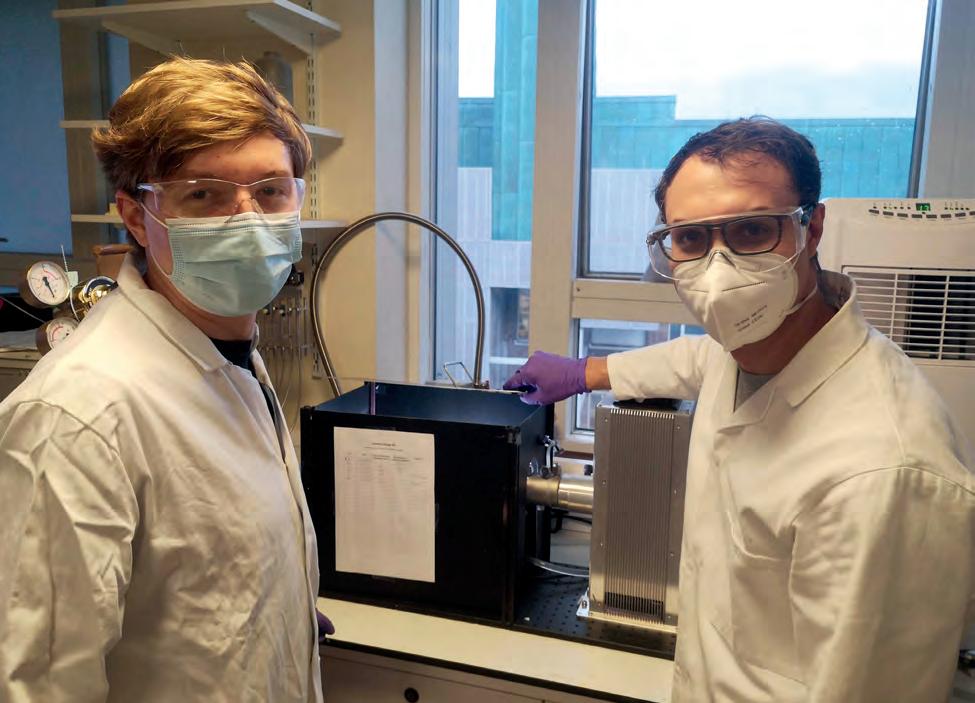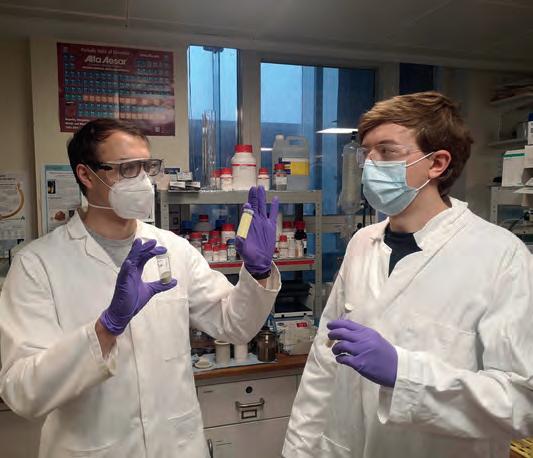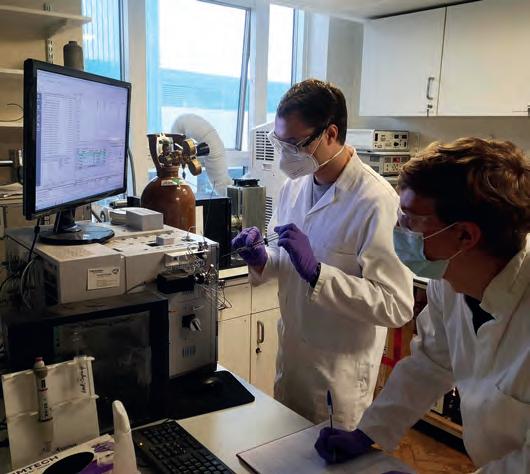
4 minute read
First steps _________________________________________________________
TThe long road from brilliant research to a marketable product is dotted with metaphorical potholes. So, what is it like to take the rst steps along this path?
The solar light simulator creates realistic operating conditions for testing the catalysts.
Dr Michael Stanton and Dr Stuart Linley are in the early stages of commercialising a photoreforming process developed in the Reisner Lab, which produces hydrogen fuel from plastic waste. They share their experiences here:
Stuart
This comes out of our colleague Taylor Uekert’s work on photoreforming, which uses sunlight, water, and low-cost non-precious metal catalyst materials to ‘reform’ organic waste into hydrogen. Currently 95% of hydrogen production is via steam reforming, which uses methane--a fossil fuel and greenhouse gas. Our goal is to o er a green alternative that is price competitive with other methods.
Michael
One of the big challenges is scalability. At the moment the process can only make a small amount - the biggest reactor Taylor used in her research was ve by ve centimetres. Stuart is developing a circular reactor with a 20cm diameter, but by the end of next year our aim is to produce a reactor which is one metre squared.
Stuart
And it must be economically viable. Towards the end of her project, Taylor was looking at immobilising catalysts on glass panels, so they can be retained and recycled when the waste solution is ushed away, which helps reduce costs. I am experimenting with panels, glass tubes and even oating photocatalysts such as micron-sized styrofoam or glass bubbles.
We can also make the catalysts more e ective by using a larger portion of the solar spectrum. Taylor used carbon nitride and a nickel phosphide co-catalyst because carbon nitride is active under visible light

Michael Stanton (R) and Stuart Linley with tubes containing the catalyst materials.
unlike other catalysts, which only absorb in the ultraviolet region. Only about ve percent of the solar spectrum is UV light, where 45 percent is visible light.
Michael
My focus is the commercial application of the research. We have a grant from the EPSRC Impact Acceleration Account follow-on fund, which speci cally supports the early-stage development of technology to make an idea more attractive for commercial investment -- this will help fund the reactors and catalysts that Stuart is working on. We’ve also been awarded an ERC Proof of Concept grant, which covers activities at the very early stage of turning research into a commercial proposition. These grants have allowed me to meet companies and potential partners to survey their views on photoreforming and assess the market.
Stuart
My undergrad and postgraduate degrees were in Nanotechnology and Engineering at the University of Waterloo in Canada. During my summers and holidays I worked with a Professor developing recyclable nanomaterials for water treatment. We eventually incorporated a company called H2nanO, which uses photocatalysis to treat oil sands wastewater. The process uses the sun and recyclable catalyst materials to treat contaminated wastewater. So my background made me a good match for this project. [Editor’s note: Extracting petroleum from oil sands requires large amounts of water, which must then be treated.]
Michael
I did my PhD in the NanoDTC here, which exposed me early on to a great ecosystem of impact and entrepreneurship. We had courses on the basics of writing a business plan, pitching an idea and analysing a market. I enrolled in the E-tech programme at the Judge Institute (now called EnterpriseTECH), which provided in-depth training on raising investment, understanding a market and other aspects of start-ups.
I became interested in photoreforming after meeting Professor Reisner, who is one of the co-directors of the NanoDTC, and Taylor, who was one year behind me in the course. I was awarded the NanoDTC Translational Prize for the photoreforming topic, which gave me a one-year fellowship. This also funded me to attend the Impulse programme at the Maxwell Centre, where I had smallgroup mentoring and access to a network of successful entrepreneurs, angel investors and patent lawyers. I’m still in touch with many of the contacts I made through that programme, and regularly talk to my mentor.
The entire Cambridge ecosystem has been very supportive of translational research. The grants have allowed the funding and time to look into all of the issues we have mentioned, and time is very clearly what is needed.

Using a gas chromatograph to measure hydrogen output.
Editor’s notes: Taylor Uekert was awarded her PhD and is now a postdoctoral researcher in the resources and sustainability group at the National Renewable Energy Lab in Colorado.
Photoreforming has been chosen as one of six nalists in the Chris Abell Postdoc Business Plan Competition run by Cambridge Enterprise. The contenders will pitch their business ideas in front of an audience of experts in spin-out investment at The Grand Finale on 11/11/21. Three prizes of £20k, 10k and 5k in funding will be awarded, and the rst place winner will also have the opportunity to pitch at a Cambridge Enterprise Venture Partners dinner, an investor forum of venture capitalists and business angels.










